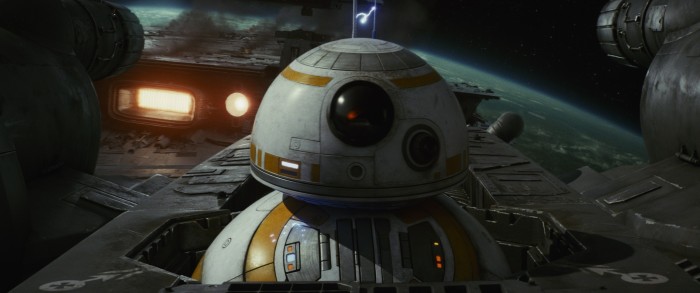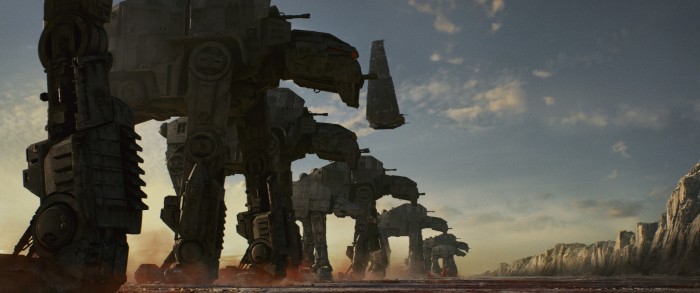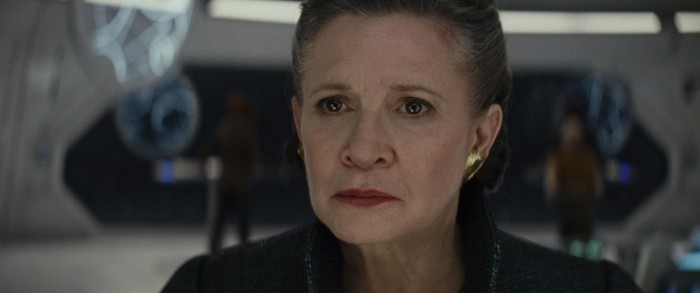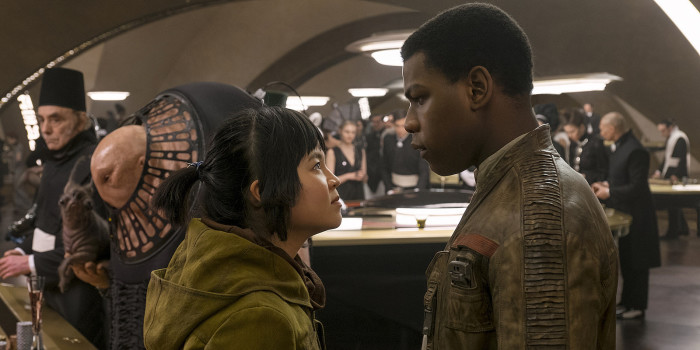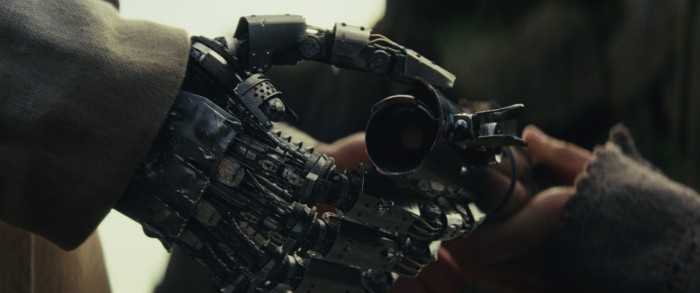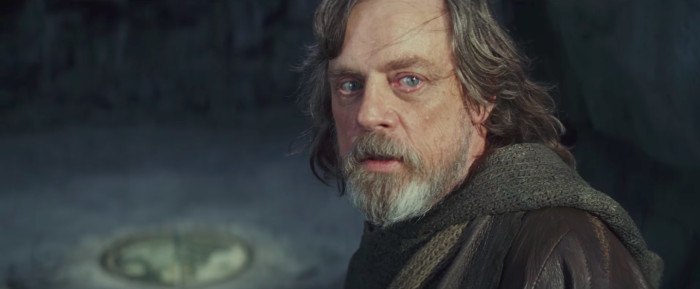Addressing The Four Biggest 'The Last Jedi' Fan Complaints
Critically and commercially, Star Wars: The Last Jedi has been an unqualified success. In that respect, writer-director Rian Johnson's prayers have been answered. Yet over its opening weekend, a narrative of swift backlash built up around the film. Usually, it's fans who have to defend a big blockbuster against critics; this time it's the other way around.
Though it received an "A" CinemaScore, The Last Jedi received the lowest audience score on Rotten Tomatoes out of any of the Star Wars movies, even the much-maligned prequels. Some have called into question the validity of that score, attributing it to possible vote brigading, whereby people set up fake user accounts to manipulate ratings. However, there are enough intelligent voices out there raising issues of genuine concern with parts of the movie that it might be constructive to look at what some of those issues are.
Let's address the reasons why certain storytelling choices might have been made. To do that, we will need to go into full spoiler mode, so if you have not seen the movie yet, feel free to turn away.
As a lifelong Star Wars fan, I personally feel like The Last Jedi delivers in a deep and impressive way, managing to be both consistently surprising and emotionally gratifying at the same time. Having just written about how Luke Skywalker is the greatest Star Wars character, I naturally find Mark Hamill to be the film's MVP. I was also glad to see The Last Jedi dispense with some of the less successful elements of the otherwise enjoyable Force Awakens, such as Kylo Ren's muffled mask-voice.
Sure, it's not a perfect movie. With the lone possible exception of The Empire Strikes Back, no Star Wars movie can claim to be perfect. But as I left the theater on Friday, and then again on Saturday, my spirits were soaring. Rich and rewarding, full of twists and turns as well as great action scenes and memorable imagery, The Last Jedi struck me as being especially interesting in terms of its themes. This is a Star Wars movie that wears its heart on its sleeve and is openly thoughtful in the way it strives for greater meaning.
Yet I have to admit, for all its home-run beats, moments it knocked out of the park, there is more than one jarring moment in the movie that does strike me as a swing-and-a-miss — like something you would see in the prequels or the special editions. As much as The Last Jedi is immensely satisfying on an emotional, intellectual, and aesthetic level (almost to the point of being the last Star Wars movie I would ever need to see should the world end tomorrow), if I divorce myself from it emotionally, I can see where a few stand-out scenes have to be treated with forgiving eyes or given a measure of polite justification. Let's talk about four of them.
Complaint #1 - Poe Dameron’s “Holding for Hux” Joke
At the beginning of The Last Jedi, there's a rather intrusive joke where pilot Poe Dameron, played by Oscar Isaac, essentially makes a kind of space prank call to the First Order's General Hux, played by Domhnall Gleeson. The fact that this moment serves as an on-screen Ex Machina reunion for the two actors has regrettably gotten overshadowed by the offbeat rhythm of the scene, which sees Poe Dameron holding the line, seemingly unwilling to recognize that this is the real General Hux he is talking to via space-speaker-phone. He even manages to work in a little jab at the increasingly flabbergasted Hux's mother. The moment is jarring only because it feels somewhat at odds with the grand, operatic tone of Star Wars — or should I say, Star Wars as we have known it up till this point.
Honestly, of all the questionable elements that The Last Jedi contains, I feel like this one is the least defensible from nitpicks. On the /Filmcast, our own Peter Sciretta likened this moment to something from a Saturday Night Live sketch, and I'm inclined to agree with him. It's amusing, but the joke landed with a thud in my theater (though admittedly, the auditorium was filled with a stoic Japanese audience who were watching the movie in subtitles). However, I'm going to play devil's advocate with this scene.
One thing Star Wars has carried over from George Lucas into the Disney era under Kathleen Kennedy is the idea that the movies should "rhyme" like poetry. We have already seen this enacted in body language, just between The Force Awakens and Rogue One. Think of the way Han Solo and K-2SO both raise their blasters at one point and shoot straight to the side without looking. Or the way Finn and Cassian Andor both balk at the sight of a young woman who clearly does not need their help as she leaps into a street fight and demonstrates total self-sufficiency.
Callbacks like these are wholly intentional, meant to build up a kind of visual harmony, or connective tissue, between the movies. There are copious callbacks to the original trilogy, too, but whereas The Force Awakens seems content merely to mirror A New Hope and The Empire Strikes Back in certain scenes, The Last Jedi seems determined to be the reflection in the mirror that starts talking back, mismatching its owner's movements in weird, wild ways.
Consider how the First Order's gorilla walkers look on the white salt surface of the planet Crait. It's basically the Battle of Hoth all over again, but then the Resistance's rattling ski speeders start kicking up salt, leaving red streaks everywhere.
When Rey is brought before Supreme Leader Snoke in his throne room, a bold red background and the crimson armor of Snoke's akai samurai, the Elite Praetorian Guard, immediately offset the scene as something different than Return of the Jedi. Within the context of these new arresting visuals, the scene nonetheless evokes the familiar imagery of Return of the Jedi with the way it draws Rey over to the window, where she sees the fleet of good-guy spaceships being destroyed as our 2017 Emperor Palpatine analogue, Snoke, monologues about how foolish and futile her attempts at heroics are. No sooner does he get done gloating than the scene makes a sharp left turn and utterly subverts audience expectations, cutting Snoke in half with a lightsaber, just like Darth Maul.
To bring this back to Poe Dameron, Poe's "holding for Hux" joke echoes his complete lack of deference for Kylo Ren's mask at the beginning of The Force Awakens. The only difference is that director J.J. Abrams filmed that scene with a kinetic energy that kept things constantly moving, as is his wont. Rian Johnson, on the other hand, allows his self-aware Star Wars humor to play out a little longer. Rather than just making it a quick aside, he actually makes it the focus of an extended scene, one that is, arguably, as true to the character of Poe Dameron as Stormtrooper Han's "Boring conversation, anyway" was to his character in A New Hope.
What gives the scene further utility, perhaps, is just that it raises a red flag as if to say: this is not your grandfather's Star Wars movie.
Complaint #2 - Leia Flies Through Space
The sad passing of Carrie Fisher at the age of 60 last December has unavoidably altered the viewing experience of The Last Jedi, inasmuch as a real woman whose life came to be identified with an iconic screen role died during the movie's post-production process. Fisher's scenes were already completed before she passed, and there are at least two places in the movie where they could have conceivably phased her character out, either by killing Leia off or leaving her stuck in a coma. In an interview with Peter Sciretta, Rian Johnson has already detailed why he decided to leave Leia's full arc intact.
Nevertheless, seeing Leia's face floating in the vacuum of space, eyes closed, seemingly dead, does have the effect of manipulating the audience's emotions in ways that are probably far different from what Johnson originally intended. We know the real actress has died, so seeing this scene the first time, we are left to think: maybe this is it. This is how they deal with Fisher's death, by dispatching Leia unceremoniously in the first reel.
Leia opens her eyes, of course...and proceeds to fly through space, back to the bridge of the ship where she was standing before First Order TIE fighters blew it up and sent Admiral Ackbar to meme heaven. The scene is jarring, but it is also in line with both Original Trilogy and Expanded Universe tradition. Leia is, after all, not really flying, but rather, floating through space (or "swimming forward," let's call it, like a Gungan underwater.)
The Empire Strikes Back and Return of the Jedi had already established the ability of Force users to levitate objects, such as an X-wing fighter, or even a droid like C-3PO. Luke used telekinesis to retrieve his lightsaber in the Wampa cave. The precedent is there. Let's not forget, either, that Leia is a Skywalker, Luke's twin sister. The Force is strong in her family; she just happened to go into politics instead. Stories like Dark Empire, the early '90s Dark Horse Comic set in the Expanded Universe, also had Leia playing more of an active role as a Force user instead of just a princess or general.
Maybe part of what bugs people about this scene is that it offered a neat and tidy solution for wrapping up Leia's story. The film bucks against that in honor of Fisher and her later reunion scene with Hamill, among other things. Now the absence of Leia in the next movie will have to be explained some other way. Fans already have a hard time taking things at face value, even when those things would otherwise give closure to questions left open at the end of The Force Awakens. Could Kylo Ren (and Rey, who voices the same sentiment aloud) have been lying about Rey's parents being nobodies? Is Captain Phasma really dead this time? Maybe there's a way she could cheat death again. That's how we like to think.
Leia surviving the movie leaves fans with a new lingering question. As inquiring minds wonder, "Who was Snoke? Does it matter?" and "Whatever happened to Lando Calrissian?" there is also now the question of how Episode IX will handle Fisher's untimely passing. Will the story jump ahead in time, allowing the Resistance to rebuild off-screen between movies (and Leia's death to be attributed to natural aging, similar to Sean Connery's Henry Jones character in Indiana Jones and the Kingdom of the Crystal Skull)? Presuming J.J. Abrams does not consign Leia's fate to his infamous mystery box, we should know the answer to that question in 2019 when Episode IX hits. In the meantime, fans are free to speculate during the wait. That's part of the fun.
Complaint #3 - Canto Bight (and a Quick Note on the Force)
Superficially, the Canto Bight sequence seems pointless. From a basic plot perspective, it accomplishes nothing, insofar as Finn and Rose fail in their mission. If certain pointy-eared Force ghosts are to be believed, however, then failure may actually be the greatest teacher.
The Canto Bight casino planet feels like an attempt to build a high-concept new world that is more distinct than, say, the scavenger planet of Jakku is from the desert planet of Tattooine. As we become immersed in this environment and meet some of the colorful background aliens who populate it, it starts to feel like something out of the world of Harry Potter. The chase scene on the back of space horses, known as fathiers, conjures up memories of Ewan MacGregor riding a CG salamander in Revenge of the Sith. Another intentional echo? Who's to say.
Is the movie trying to say something with Canto Bight? Of course it is. The whole milieu would appear to be an overt allegory of the divide between the haves and have-nots, how the privileged few in this world — the 1%, as it were — are perhaps doomed to be overridden at some point when at last the 99% decide to take back freedom in their hearts (as represented by the galloping space horses).
Again, it is jarring to see Star Wars get political. That seems more like Star Trek's thing. But as Sarah Jeong, senior writer at The Verge, recently noted on Twitter ... in Revenge of the Sith, Ian McDiarmid's Palpatine/Darth Sidious "screams 'UNLIMITED POWER!!!' and then throws Senate seats at Yoda." And that's before you remember that the original Star Wars is very much George Lucas reacting to the Vietnam War through the prism of space opera.
In Episode III Palpatine screams "UNLIMITED POWER!!!" and then throws Senate seats at Yoda https://t.co/lCufjowDZf
— sarah jeong (@sarahjeong) December 15, 2017
The scene she's referencing came out in 2005, at the height of the George W. Bush presidential administration. So much for Star Wars being apolitical.
They say it's not courteous to talk about politics and religion — those two things especially — at the dinner table. But since we've already broached one subject, we might as well bring up the other. Back in September, when I wrote a news article about Rian Johnson praying for the success of The Last Jedi at a temple in Japan, I found an old tweet of his where he said he grew up religious and was once a devoted Christian. As someone with a similar religious background, I felt like I could see where that may have informed some of his choices in this movie with regards to the Force. Basically, if the Force is God in the Star Wars universe, and the Jedi and the Skywalkers were God's chosen people (cue Ewan McGregor wailing, "You were the Chosen Ones!"), what does that mean for everyone else?
Now the Force has been made available to all people. Everything up to this point has been the Old Testament of Star Wars. Last Jedi forms a new covenant for the franchise going forward.
This is embodied in the noble figure of broom boy, the stable kid at the end who is left staring up at the stars right before the movie cuts to its closing credits. Broom boy is a nobody, very much like Rey herself, but he, too, is in touch with the Force. No longer are Skywalkers the only ones destined for greater things in the Star Wars universe. For all we know, broom boy could be the central protagonist of the new trilogy of Rian Johnson Star Wars films that has been announced. Though as our own Chris Evangelista argues, broom boy's small but significant role in this movie may have just been intended to show "that the stories and legends of Star Wars will continue to spread throughout the galaxy, long after our current heroes are dead and gone," and "that the Star Wars universe is vast, and there are people and stories in it that exist beyond the scope of what we've seen so far."
Complaint #4 - Yoda, God of Thunder
Bringing the Force to the people is why Yoda shows up to summon some lightning and burn down the tree that once housed the sacred Jedi texts. Yoda's reappearance in this movie is initially jarring, too, if only because the character's visual design has been so wobbly across the six live-action films that he has appeared in. First he was a great puppet, then he was a bad puppet, and then he was a CGI creation. Then his backward-talking became ever-more stilted and ridiculous, his lines becoming a jumble of self-parody. (Cue George Lucas typing, "Not if anything to say about it I have.")
Now Yoda is a puppet again, but something still looks a little off about his face. Maybe it's just that they achieved the glowing blue Force-ghost effect around him in a different way than they did at the end of Return of the Jedi. I don't know. All I can say is that when I saw The Last Jedi the first time, the scene with Yoda took me out of the movie a little.
On a second viewing, I was able to relax into it more, and I think it is appropriate that Yoda, the saga's wisest character, should be the one to show up to set fire to the past. "Let the past die," Kylo Ren says. "Kill it, if you have to. That's the only way to become what you were meant to be." They may be going in different directions, but Ben Solo and Yoda have a similar line of thinking.
One of the many beautiful images that The Last Jedi leaves us with is that of Luke and Yoda, silhouetted from behind, as they sit back next to each other on a hill to watch the past go up in flames. The past is not meaningless. It has brought us to where we are today. But if the Star Wars franchise is ever going to progress, maybe it's time to let go of some things, so the franchise can become what it was meant to be — back when George Lucas was still young and pure, entertaining ideas about other visionary directors coming in and competing, trying to outdo each other to see who could make the best Star Wars movie.
Old man Luke is a flawed character, a hero who can only disappoint those who believe in him, yet he Force-projects an idealized image of himself onto the battlefield to become a legend that will inspire future generations. It is only fitting that at the tail end of the franchise's 40th anniversary year, Luke Skywalker should bring Star Wars full circle, giving closure to the first four decades of movies by staring up at a binary sunset again like he did when we first met him back on the Tatooine farm all those years ago. Like Obi-Wan and Yoda before him, Luke fades away, but he never did get the chance to teach Rey her third and final lesson. Maybe he will come back as a Force ghost to do that in Episode IX.
The Star Wars franchise is in a good place now, where it feels like every new movie outdoes the former one and is hailed by critics and fans (well, some of them, anyway) as the "best since Empire Strikes Back." I grew up loving the Original Trilogy; I struggled with the prequels; I liked The Force Awakens; I really liked Rogue One. But The Last Jedi is a film that brought even more tears to my eyes than the poignant, self-sacrificing fate of Rogue One's characters. And for that, I can overlook the flaws.

